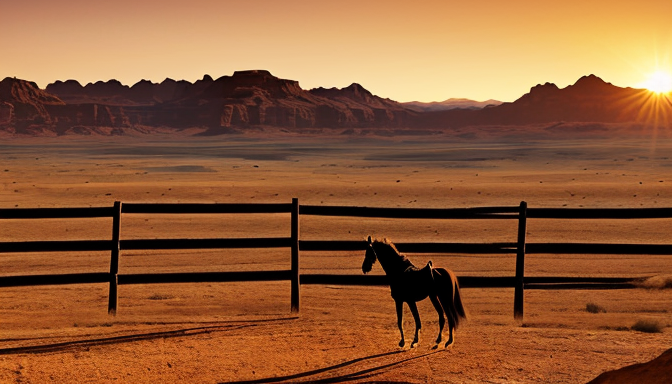When you think of the Western genre, what comes to mind? Perhaps it’s the sound of spurs jingling, the dust swirling in the air, or the iconic showdown at high noon. Western films have carved a unique niche in the landscape of American cinema, serving as a mirror reflecting the values, struggles, and dreams of a nation. These films transport us to a time when the frontier was still wild and untamed, where every dusty trail held the promise of adventure and danger. They’re not just stories about cowboys and outlaws; they encapsulate the spirit of exploration and the quest for identity.
From the sweeping plains of the Great Plains to the rugged mountains of the Rockies, the Western frontier has been a backdrop for countless tales. Classic films like “The Good, the Bad and the Ugly” and “Stagecoach” set the stage for what would become a beloved genre, showcasing legendary directors like John Ford and actors like John Wayne. These films didn’t just entertain; they shaped the cultural narrative of America, creating archetypes that continue to resonate today.
As we delve deeper into this cinematic journey, it’s fascinating to see how the genre has evolved. Modern Westerns, such as “No Country for Old Men” and “True Grit,” challenge traditional tropes, offering fresh perspectives that reflect our changing society. They remind us that the Western frontier is not just a place; it’s a state of mind—a canvas for exploring the complexities of human nature and morality. So, grab your popcorn and saddle up as we explore the dusty trails of Western themes in film!
Classic Westerns: The Golden Age
The Golden Age of Westerns is a captivating chapter in the annals of cinema, where the rugged landscapes of the American frontier became the backdrop for epic tales of bravery, honor, and conflict. Films like “Stagecoach” and “The Good, the Bad and the Ugly” not only showcased the talents of legendary directors such as John Ford and Sergio Leone but also solidified the Western genre as a cultural touchstone. These films introduced audiences to memorable characters—cowboys, outlaws, and lawmen—who embodied the spirit of adventure and the struggle for justice in a lawless land.
During this era, the Western genre became a mirror reflecting the values and challenges of American society. The themes of individualism, morality, and the conflict between civilization and wilderness were prevalent, resonating deeply with audiences. For many, these films were more than just entertainment; they were a way to explore identity and the notion of the American Dream. The iconic imagery of vast deserts, galloping horses, and shootouts at high noon became synonymous with the genre, setting a standard that would influence countless films.
As we delve deeper into this cinematic treasure trove, it’s essential to recognize how these classic Westerns have shaped not only the film industry but also the broader narrative of American storytelling. They laid the groundwork for future filmmakers to explore and reinterpret the genre, proving that the dusty trails of the West still hold many stories waiting to be told.

Modern Interpretations: A New Frontier
In recent years, the Western genre has undergone a fascinating transformation, evolving from its traditional roots into a canvas for modern storytelling. Filmmakers are now taking the dusty trails of yesteryears and infusing them with contemporary themes that resonate with today’s audiences. This shift isn’t just a trend; it’s a revolution in how we perceive the American frontier.
Gone are the days when Westerns were solely about gunfights and saloon brawls. Today’s films often delve into complex issues such as identity, race, and gender, reflecting the multifaceted nature of modern society. For instance, movies like “The Harder They Fall” and “True Grit” not only showcase thrilling narratives but also challenge the stereotypical portrayals of cowboys and outlaws.
The beauty of these modern interpretations lies in their ability to capture the essence of the Western spirit while addressing relevant social issues. They invite viewers to ponder questions like: What does it mean to be a hero in today’s world? How do the struggles of the past echo in our current lives? By weaving together
- historical context
- personal stories
- and cultural critiques
, these films create a rich tapestry that is both entertaining and thought-provoking.
In conclusion, the Western genre is not just a relic of the past; it is a living, breathing narrative that continues to shape American storytelling. As we venture into this new frontier, we are reminded that the essence of the West is not merely in the landscapes or the shootouts, but in the stories that connect us all.
Frequently Asked Questions
- What defines a classic Western film?
Classic Westerns are typically characterized by their portrayal of rugged individualism, moral conflicts, and the iconic landscapes of the American West. They often feature heroic cowboys, outlaws, and strong moral dilemmas, set against a backdrop of lawlessness and frontier life.
- How have modern Westerns evolved from their classic counterparts?
Modern Westerns often subvert traditional tropes by introducing complex characters and contemporary issues. They reflect societal changes, such as gender roles and race relations, while still capturing the essence of the genre. Think of them as a fresh take on an old story, where the past meets the present.
- Which films are considered essential viewing for Western fans?
Some must-watch films include “The Good, the Bad and the Ugly,” “Unforgiven,” and “No Country for Old Men.” Each of these films offers a unique perspective on the Western genre, blending classic elements with innovative storytelling.
- What cultural significance do Western films hold?
Western films have played a crucial role in shaping American identity and mythology. They explore themes of freedom, justice, and morality, reflecting the nation’s ideals and struggles throughout history.